Business Models Enterprise Model Innovation Of Xiaomi
VerifiedAdded on 2022/08/17
|21
|3936
|15
AI Summary
Contribute Materials
Your contribution can guide someone’s learning journey. Share your
documents today.

Running head: CASE XIAOMI
Assessment Task 3: Case Xiaomi
Name of the student:
Name of the university:
Author note:
Assessment Task 3: Case Xiaomi
Name of the student:
Name of the university:
Author note:
Secure Best Marks with AI Grader
Need help grading? Try our AI Grader for instant feedback on your assignments.
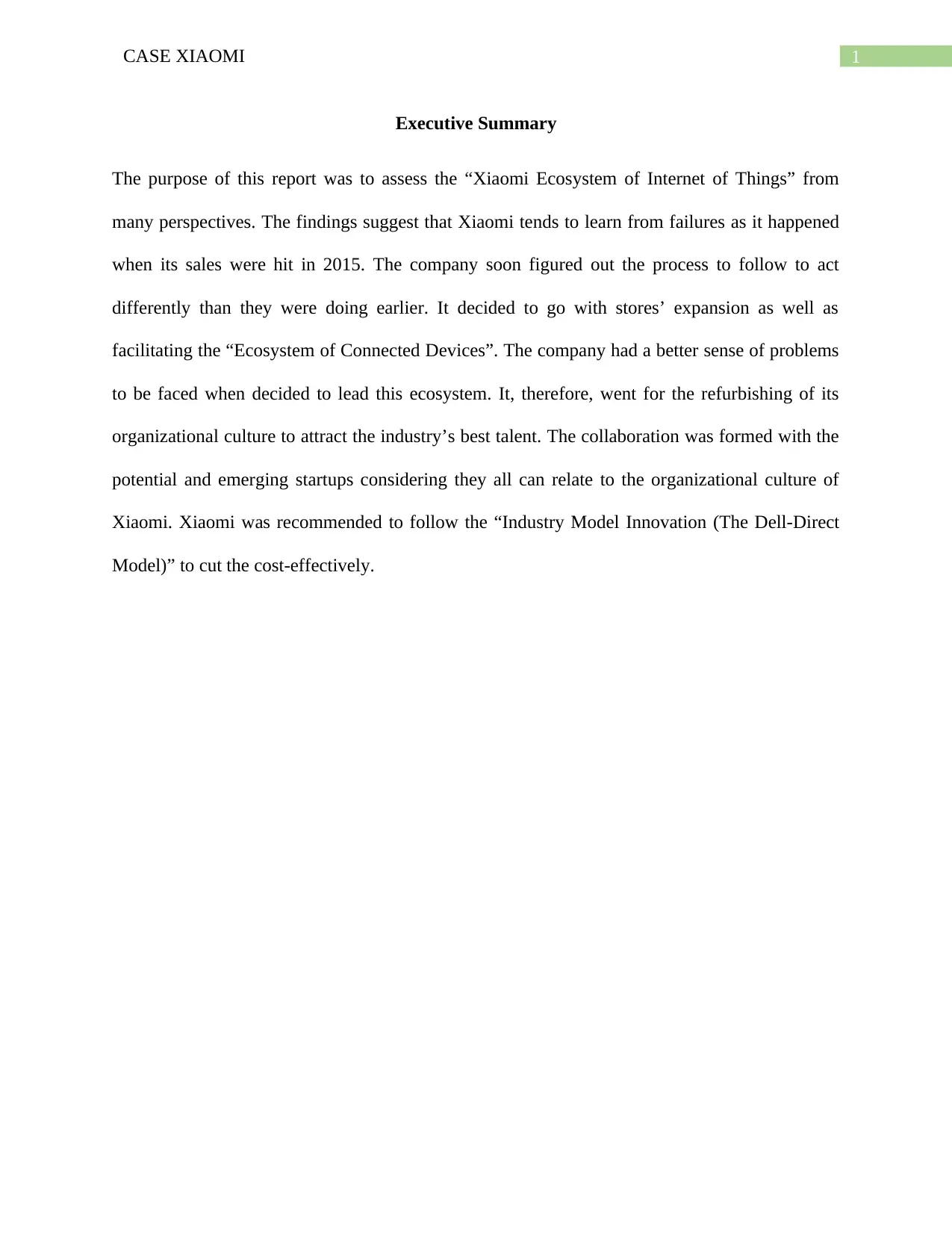
1CASE XIAOMI
Executive Summary
The purpose of this report was to assess the “Xiaomi Ecosystem of Internet of Things” from
many perspectives. The findings suggest that Xiaomi tends to learn from failures as it happened
when its sales were hit in 2015. The company soon figured out the process to follow to act
differently than they were doing earlier. It decided to go with stores’ expansion as well as
facilitating the “Ecosystem of Connected Devices”. The company had a better sense of problems
to be faced when decided to lead this ecosystem. It, therefore, went for the refurbishing of its
organizational culture to attract the industry’s best talent. The collaboration was formed with the
potential and emerging startups considering they all can relate to the organizational culture of
Xiaomi. Xiaomi was recommended to follow the “Industry Model Innovation (The Dell-Direct
Model)” to cut the cost-effectively.
Executive Summary
The purpose of this report was to assess the “Xiaomi Ecosystem of Internet of Things” from
many perspectives. The findings suggest that Xiaomi tends to learn from failures as it happened
when its sales were hit in 2015. The company soon figured out the process to follow to act
differently than they were doing earlier. It decided to go with stores’ expansion as well as
facilitating the “Ecosystem of Connected Devices”. The company had a better sense of problems
to be faced when decided to lead this ecosystem. It, therefore, went for the refurbishing of its
organizational culture to attract the industry’s best talent. The collaboration was formed with the
potential and emerging startups considering they all can relate to the organizational culture of
Xiaomi. Xiaomi was recommended to follow the “Industry Model Innovation (The Dell-Direct
Model)” to cut the cost-effectively.
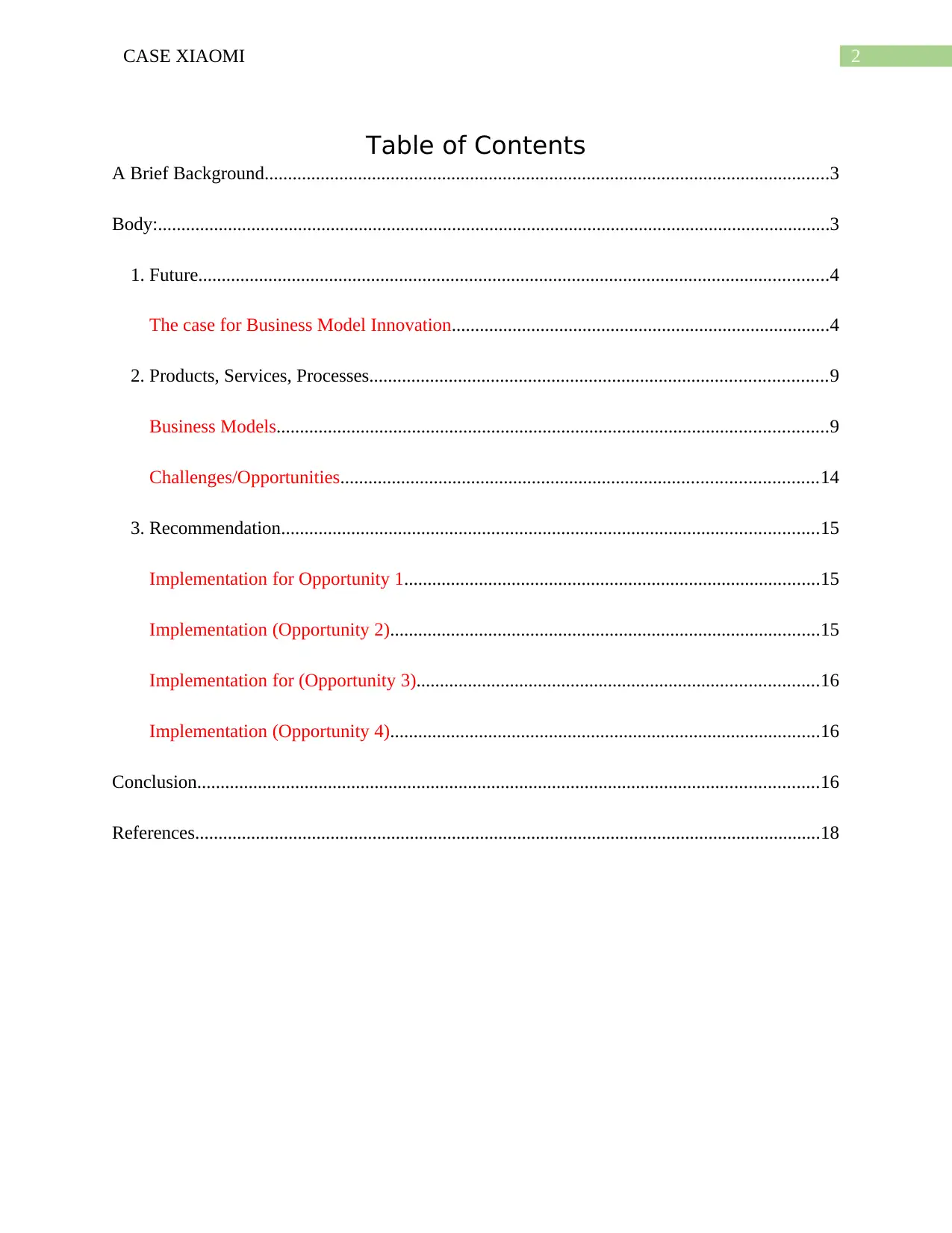
2CASE XIAOMI
Table of Contents
A Brief Background.........................................................................................................................3
Body:................................................................................................................................................3
1. Future.......................................................................................................................................4
The case for Business Model Innovation.................................................................................4
2. Products, Services, Processes..................................................................................................9
Business Models......................................................................................................................9
Challenges/Opportunities......................................................................................................14
3. Recommendation...................................................................................................................15
Implementation for Opportunity 1.........................................................................................15
Implementation (Opportunity 2)............................................................................................15
Implementation for (Opportunity 3)......................................................................................16
Implementation (Opportunity 4)............................................................................................16
Conclusion.....................................................................................................................................16
References......................................................................................................................................18
Table of Contents
A Brief Background.........................................................................................................................3
Body:................................................................................................................................................3
1. Future.......................................................................................................................................4
The case for Business Model Innovation.................................................................................4
2. Products, Services, Processes..................................................................................................9
Business Models......................................................................................................................9
Challenges/Opportunities......................................................................................................14
3. Recommendation...................................................................................................................15
Implementation for Opportunity 1.........................................................................................15
Implementation (Opportunity 2)............................................................................................15
Implementation for (Opportunity 3)......................................................................................16
Implementation (Opportunity 4)............................................................................................16
Conclusion.....................................................................................................................................16
References......................................................................................................................................18
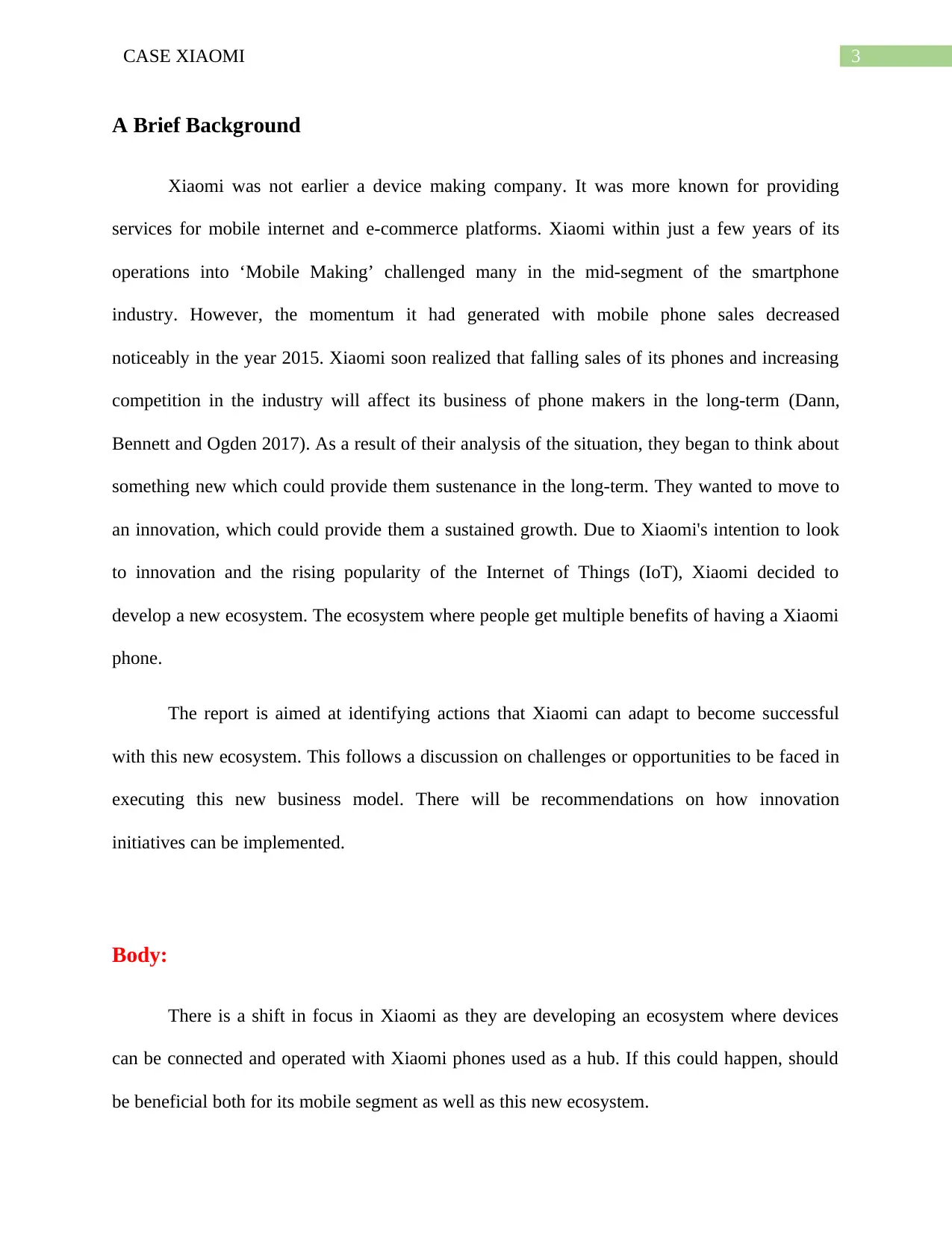
3CASE XIAOMI
A Brief Background
Xiaomi was not earlier a device making company. It was more known for providing
services for mobile internet and e-commerce platforms. Xiaomi within just a few years of its
operations into ‘Mobile Making’ challenged many in the mid-segment of the smartphone
industry. However, the momentum it had generated with mobile phone sales decreased
noticeably in the year 2015. Xiaomi soon realized that falling sales of its phones and increasing
competition in the industry will affect its business of phone makers in the long-term (Dann,
Bennett and Ogden 2017). As a result of their analysis of the situation, they began to think about
something new which could provide them sustenance in the long-term. They wanted to move to
an innovation, which could provide them a sustained growth. Due to Xiaomi's intention to look
to innovation and the rising popularity of the Internet of Things (IoT), Xiaomi decided to
develop a new ecosystem. The ecosystem where people get multiple benefits of having a Xiaomi
phone.
The report is aimed at identifying actions that Xiaomi can adapt to become successful
with this new ecosystem. This follows a discussion on challenges or opportunities to be faced in
executing this new business model. There will be recommendations on how innovation
initiatives can be implemented.
Body:
There is a shift in focus in Xiaomi as they are developing an ecosystem where devices
can be connected and operated with Xiaomi phones used as a hub. If this could happen, should
be beneficial both for its mobile segment as well as this new ecosystem.
A Brief Background
Xiaomi was not earlier a device making company. It was more known for providing
services for mobile internet and e-commerce platforms. Xiaomi within just a few years of its
operations into ‘Mobile Making’ challenged many in the mid-segment of the smartphone
industry. However, the momentum it had generated with mobile phone sales decreased
noticeably in the year 2015. Xiaomi soon realized that falling sales of its phones and increasing
competition in the industry will affect its business of phone makers in the long-term (Dann,
Bennett and Ogden 2017). As a result of their analysis of the situation, they began to think about
something new which could provide them sustenance in the long-term. They wanted to move to
an innovation, which could provide them a sustained growth. Due to Xiaomi's intention to look
to innovation and the rising popularity of the Internet of Things (IoT), Xiaomi decided to
develop a new ecosystem. The ecosystem where people get multiple benefits of having a Xiaomi
phone.
The report is aimed at identifying actions that Xiaomi can adapt to become successful
with this new ecosystem. This follows a discussion on challenges or opportunities to be faced in
executing this new business model. There will be recommendations on how innovation
initiatives can be implemented.
Body:
There is a shift in focus in Xiaomi as they are developing an ecosystem where devices
can be connected and operated with Xiaomi phones used as a hub. If this could happen, should
be beneficial both for its mobile segment as well as this new ecosystem.
Paraphrase This Document
Need a fresh take? Get an instant paraphrase of this document with our AI Paraphraser
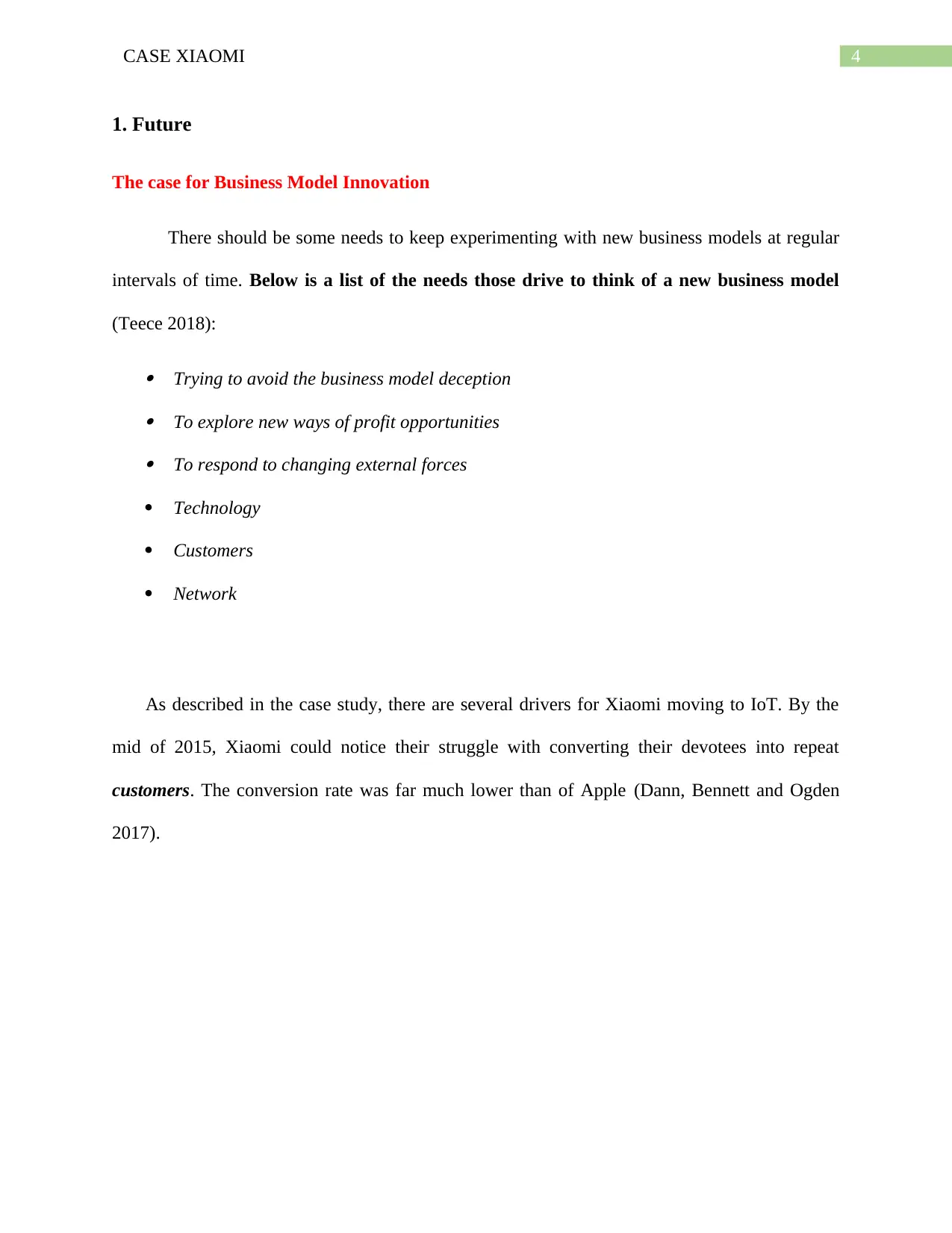
4CASE XIAOMI
1. Future
The case for Business Model Innovation
There should be some needs to keep experimenting with new business models at regular
intervals of time. Below is a list of the needs those drive to think of a new business model
(Teece 2018):
Trying to avoid the business model deception To explore new ways of profit opportunities To respond to changing external forces
Technology
Customers
Network
As described in the case study, there are several drivers for Xiaomi moving to IoT. By the
mid of 2015, Xiaomi could notice their struggle with converting their devotees into repeat
customers. The conversion rate was far much lower than of Apple (Dann, Bennett and Ogden
2017).
1. Future
The case for Business Model Innovation
There should be some needs to keep experimenting with new business models at regular
intervals of time. Below is a list of the needs those drive to think of a new business model
(Teece 2018):
Trying to avoid the business model deception To explore new ways of profit opportunities To respond to changing external forces
Technology
Customers
Network
As described in the case study, there are several drivers for Xiaomi moving to IoT. By the
mid of 2015, Xiaomi could notice their struggle with converting their devotees into repeat
customers. The conversion rate was far much lower than of Apple (Dann, Bennett and Ogden
2017).
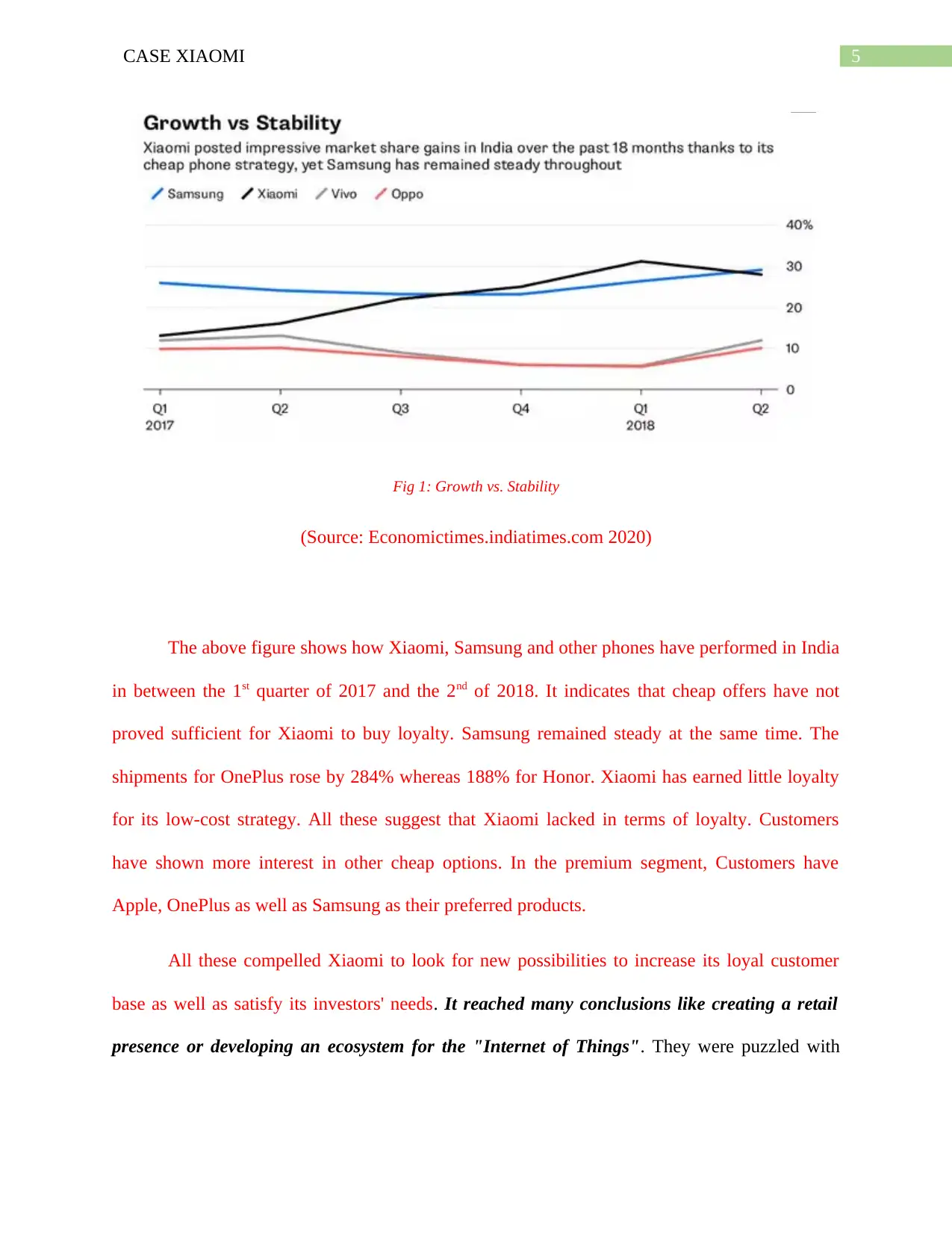
5CASE XIAOMI
Fig 1: Growth vs. Stability
(Source: Economictimes.indiatimes.com 2020)
The above figure shows how Xiaomi, Samsung and other phones have performed in India
in between the 1st quarter of 2017 and the 2nd of 2018. It indicates that cheap offers have not
proved sufficient for Xiaomi to buy loyalty. Samsung remained steady at the same time. The
shipments for OnePlus rose by 284% whereas 188% for Honor. Xiaomi has earned little loyalty
for its low-cost strategy. All these suggest that Xiaomi lacked in terms of loyalty. Customers
have shown more interest in other cheap options. In the premium segment, Customers have
Apple, OnePlus as well as Samsung as their preferred products.
All these compelled Xiaomi to look for new possibilities to increase its loyal customer
base as well as satisfy its investors' needs. It reached many conclusions like creating a retail
presence or developing an ecosystem for the "Internet of Things". They were puzzled with
Fig 1: Growth vs. Stability
(Source: Economictimes.indiatimes.com 2020)
The above figure shows how Xiaomi, Samsung and other phones have performed in India
in between the 1st quarter of 2017 and the 2nd of 2018. It indicates that cheap offers have not
proved sufficient for Xiaomi to buy loyalty. Samsung remained steady at the same time. The
shipments for OnePlus rose by 284% whereas 188% for Honor. Xiaomi has earned little loyalty
for its low-cost strategy. All these suggest that Xiaomi lacked in terms of loyalty. Customers
have shown more interest in other cheap options. In the premium segment, Customers have
Apple, OnePlus as well as Samsung as their preferred products.
All these compelled Xiaomi to look for new possibilities to increase its loyal customer
base as well as satisfy its investors' needs. It reached many conclusions like creating a retail
presence or developing an ecosystem for the "Internet of Things". They were puzzled with
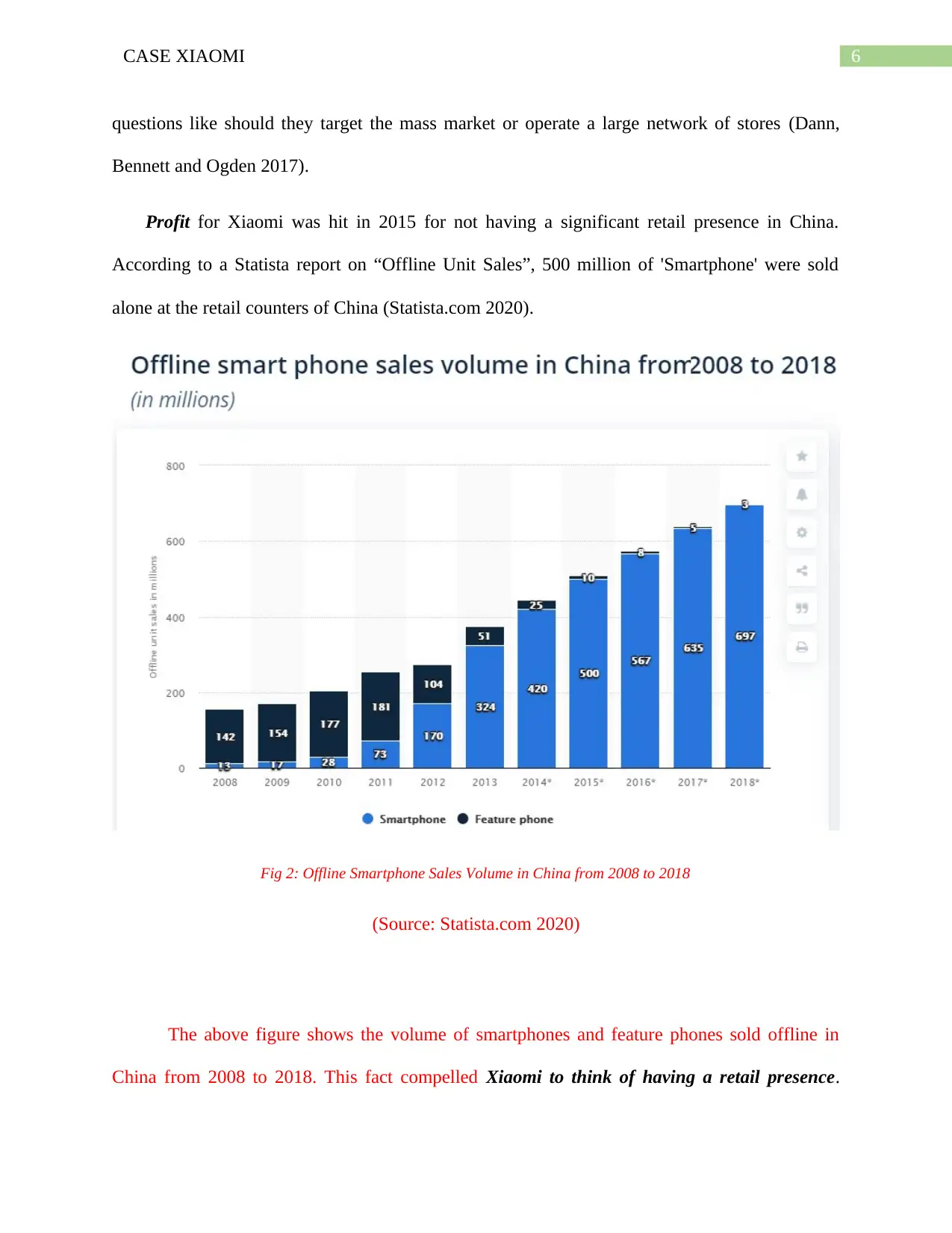
6CASE XIAOMI
questions like should they target the mass market or operate a large network of stores (Dann,
Bennett and Ogden 2017).
Profit for Xiaomi was hit in 2015 for not having a significant retail presence in China.
According to a Statista report on “Offline Unit Sales”, 500 million of 'Smartphone' were sold
alone at the retail counters of China (Statista.com 2020).
Fig 2: Offline Smartphone Sales Volume in China from 2008 to 2018
(Source: Statista.com 2020)
The above figure shows the volume of smartphones and feature phones sold offline in
China from 2008 to 2018. This fact compelled Xiaomi to think of having a retail presence.
questions like should they target the mass market or operate a large network of stores (Dann,
Bennett and Ogden 2017).
Profit for Xiaomi was hit in 2015 for not having a significant retail presence in China.
According to a Statista report on “Offline Unit Sales”, 500 million of 'Smartphone' were sold
alone at the retail counters of China (Statista.com 2020).
Fig 2: Offline Smartphone Sales Volume in China from 2008 to 2018
(Source: Statista.com 2020)
The above figure shows the volume of smartphones and feature phones sold offline in
China from 2008 to 2018. This fact compelled Xiaomi to think of having a retail presence.
Secure Best Marks with AI Grader
Need help grading? Try our AI Grader for instant feedback on your assignments.
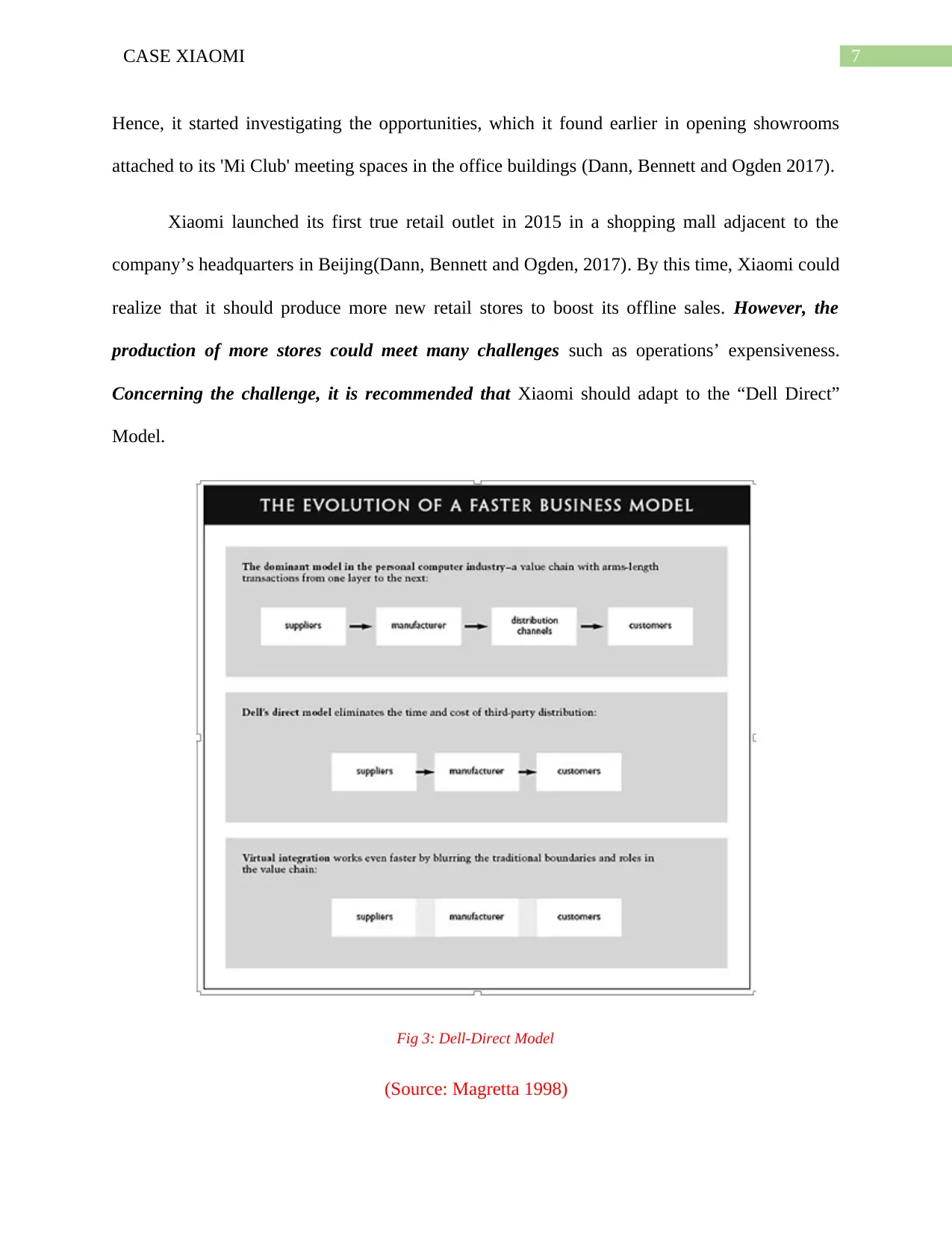
7CASE XIAOMI
Hence, it started investigating the opportunities, which it found earlier in opening showrooms
attached to its 'Mi Club' meeting spaces in the office buildings (Dann, Bennett and Ogden 2017).
Xiaomi launched its first true retail outlet in 2015 in a shopping mall adjacent to the
company’s headquarters in Beijing(Dann, Bennett and Ogden, 2017). By this time, Xiaomi could
realize that it should produce more new retail stores to boost its offline sales. However, the
production of more stores could meet many challenges such as operations’ expensiveness.
Concerning the challenge, it is recommended that Xiaomi should adapt to the “Dell Direct”
Model.
Fig 3: Dell-Direct Model
(Source: Magretta 1998)
Hence, it started investigating the opportunities, which it found earlier in opening showrooms
attached to its 'Mi Club' meeting spaces in the office buildings (Dann, Bennett and Ogden 2017).
Xiaomi launched its first true retail outlet in 2015 in a shopping mall adjacent to the
company’s headquarters in Beijing(Dann, Bennett and Ogden, 2017). By this time, Xiaomi could
realize that it should produce more new retail stores to boost its offline sales. However, the
production of more stores could meet many challenges such as operations’ expensiveness.
Concerning the challenge, it is recommended that Xiaomi should adapt to the “Dell Direct”
Model.
Fig 3: Dell-Direct Model
(Source: Magretta 1998)
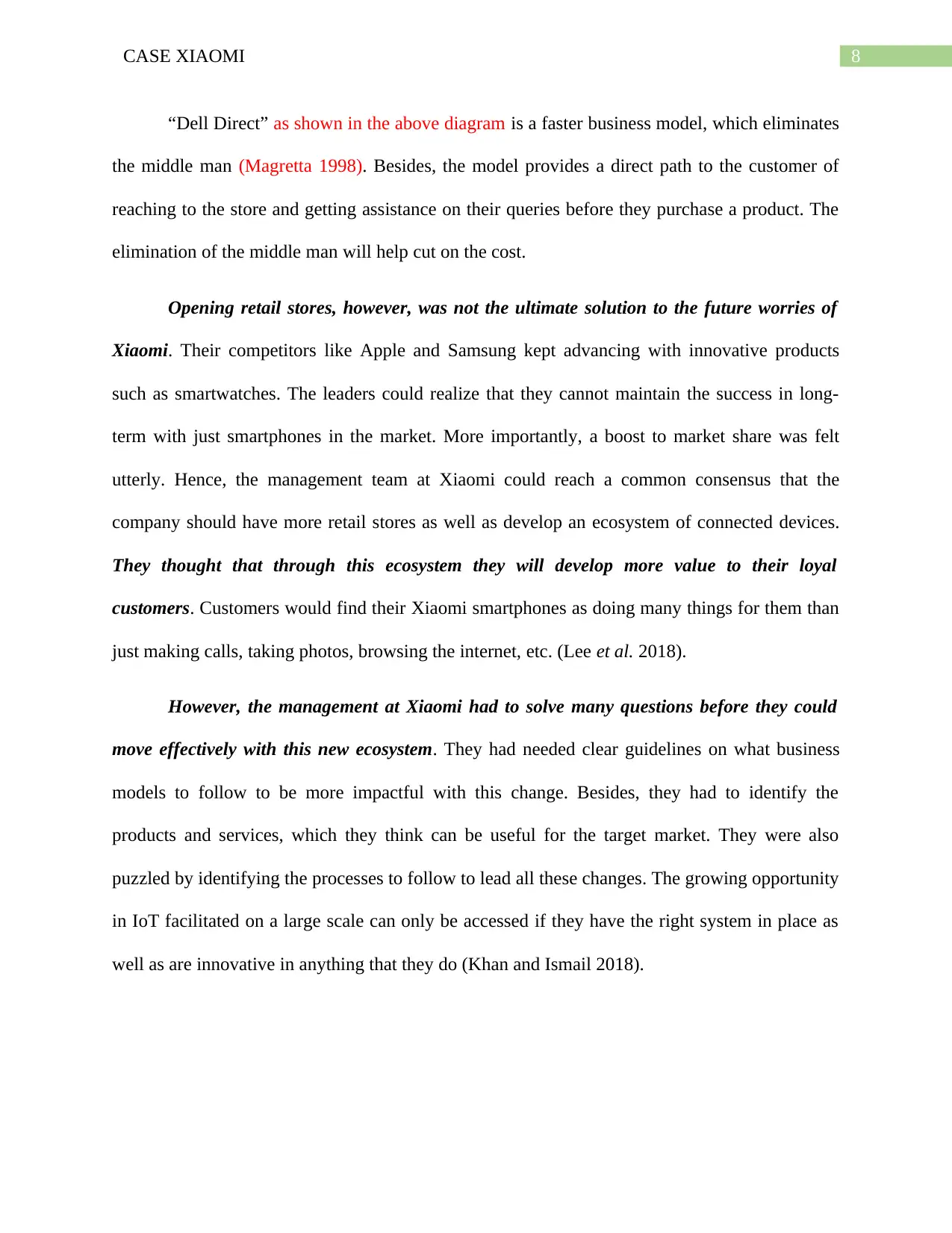
8CASE XIAOMI
“Dell Direct” as shown in the above diagram is a faster business model, which eliminates
the middle man (Magretta 1998). Besides, the model provides a direct path to the customer of
reaching to the store and getting assistance on their queries before they purchase a product. The
elimination of the middle man will help cut on the cost.
Opening retail stores, however, was not the ultimate solution to the future worries of
Xiaomi. Their competitors like Apple and Samsung kept advancing with innovative products
such as smartwatches. The leaders could realize that they cannot maintain the success in long-
term with just smartphones in the market. More importantly, a boost to market share was felt
utterly. Hence, the management team at Xiaomi could reach a common consensus that the
company should have more retail stores as well as develop an ecosystem of connected devices.
They thought that through this ecosystem they will develop more value to their loyal
customers. Customers would find their Xiaomi smartphones as doing many things for them than
just making calls, taking photos, browsing the internet, etc. (Lee et al. 2018).
However, the management at Xiaomi had to solve many questions before they could
move effectively with this new ecosystem. They had needed clear guidelines on what business
models to follow to be more impactful with this change. Besides, they had to identify the
products and services, which they think can be useful for the target market. They were also
puzzled by identifying the processes to follow to lead all these changes. The growing opportunity
in IoT facilitated on a large scale can only be accessed if they have the right system in place as
well as are innovative in anything that they do (Khan and Ismail 2018).
“Dell Direct” as shown in the above diagram is a faster business model, which eliminates
the middle man (Magretta 1998). Besides, the model provides a direct path to the customer of
reaching to the store and getting assistance on their queries before they purchase a product. The
elimination of the middle man will help cut on the cost.
Opening retail stores, however, was not the ultimate solution to the future worries of
Xiaomi. Their competitors like Apple and Samsung kept advancing with innovative products
such as smartwatches. The leaders could realize that they cannot maintain the success in long-
term with just smartphones in the market. More importantly, a boost to market share was felt
utterly. Hence, the management team at Xiaomi could reach a common consensus that the
company should have more retail stores as well as develop an ecosystem of connected devices.
They thought that through this ecosystem they will develop more value to their loyal
customers. Customers would find their Xiaomi smartphones as doing many things for them than
just making calls, taking photos, browsing the internet, etc. (Lee et al. 2018).
However, the management at Xiaomi had to solve many questions before they could
move effectively with this new ecosystem. They had needed clear guidelines on what business
models to follow to be more impactful with this change. Besides, they had to identify the
products and services, which they think can be useful for the target market. They were also
puzzled by identifying the processes to follow to lead all these changes. The growing opportunity
in IoT facilitated on a large scale can only be accessed if they have the right system in place as
well as are innovative in anything that they do (Khan and Ismail 2018).
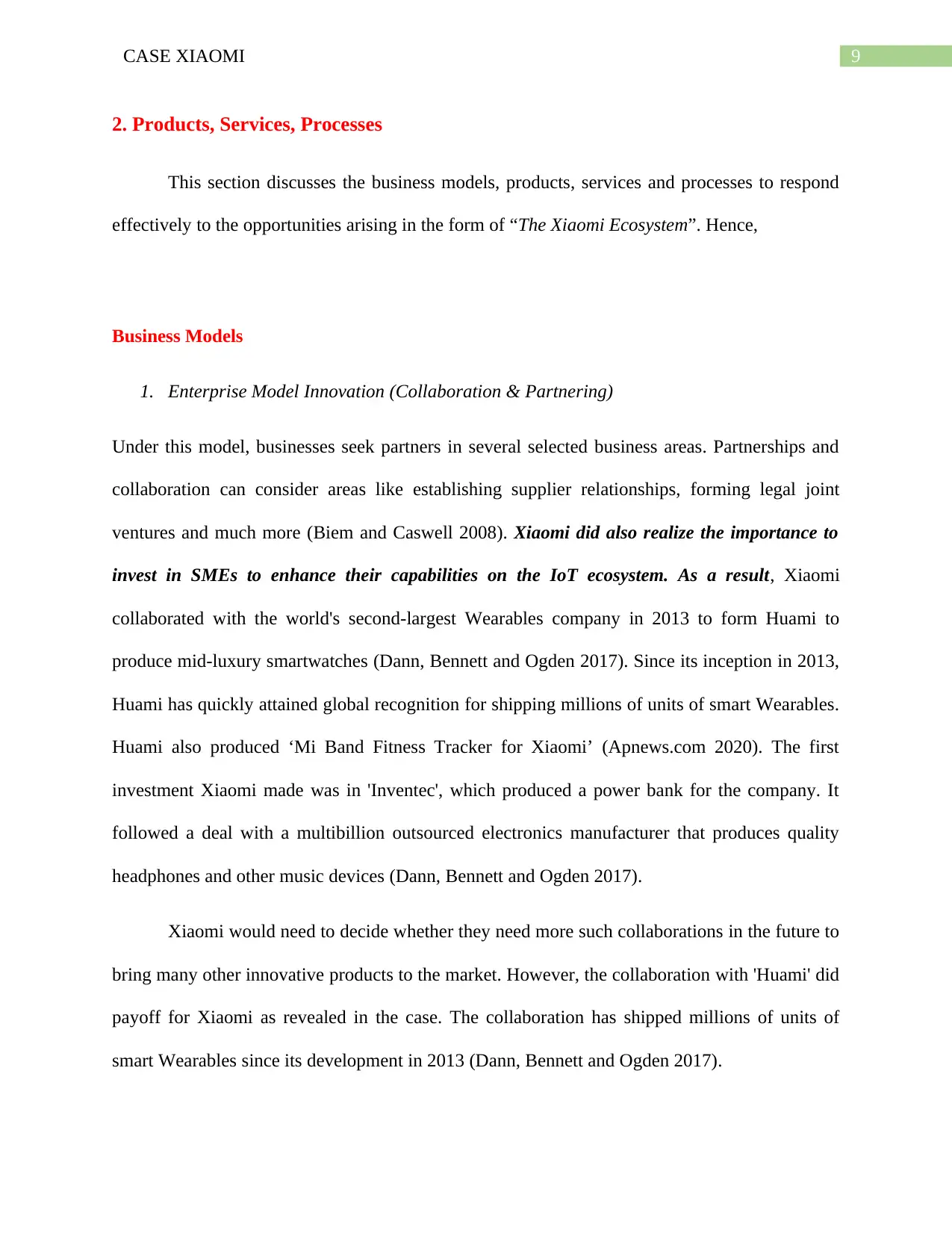
9CASE XIAOMI
2. Products, Services, Processes
This section discusses the business models, products, services and processes to respond
effectively to the opportunities arising in the form of “The Xiaomi Ecosystem”. Hence,
Business Models
1. Enterprise Model Innovation (Collaboration & Partnering)
Under this model, businesses seek partners in several selected business areas. Partnerships and
collaboration can consider areas like establishing supplier relationships, forming legal joint
ventures and much more (Biem and Caswell 2008). Xiaomi did also realize the importance to
invest in SMEs to enhance their capabilities on the IoT ecosystem. As a result, Xiaomi
collaborated with the world's second-largest Wearables company in 2013 to form Huami to
produce mid-luxury smartwatches (Dann, Bennett and Ogden 2017). Since its inception in 2013,
Huami has quickly attained global recognition for shipping millions of units of smart Wearables.
Huami also produced ‘Mi Band Fitness Tracker for Xiaomi’ (Apnews.com 2020). The first
investment Xiaomi made was in 'Inventec', which produced a power bank for the company. It
followed a deal with a multibillion outsourced electronics manufacturer that produces quality
headphones and other music devices (Dann, Bennett and Ogden 2017).
Xiaomi would need to decide whether they need more such collaborations in the future to
bring many other innovative products to the market. However, the collaboration with 'Huami' did
payoff for Xiaomi as revealed in the case. The collaboration has shipped millions of units of
smart Wearables since its development in 2013 (Dann, Bennett and Ogden 2017).
2. Products, Services, Processes
This section discusses the business models, products, services and processes to respond
effectively to the opportunities arising in the form of “The Xiaomi Ecosystem”. Hence,
Business Models
1. Enterprise Model Innovation (Collaboration & Partnering)
Under this model, businesses seek partners in several selected business areas. Partnerships and
collaboration can consider areas like establishing supplier relationships, forming legal joint
ventures and much more (Biem and Caswell 2008). Xiaomi did also realize the importance to
invest in SMEs to enhance their capabilities on the IoT ecosystem. As a result, Xiaomi
collaborated with the world's second-largest Wearables company in 2013 to form Huami to
produce mid-luxury smartwatches (Dann, Bennett and Ogden 2017). Since its inception in 2013,
Huami has quickly attained global recognition for shipping millions of units of smart Wearables.
Huami also produced ‘Mi Band Fitness Tracker for Xiaomi’ (Apnews.com 2020). The first
investment Xiaomi made was in 'Inventec', which produced a power bank for the company. It
followed a deal with a multibillion outsourced electronics manufacturer that produces quality
headphones and other music devices (Dann, Bennett and Ogden 2017).
Xiaomi would need to decide whether they need more such collaborations in the future to
bring many other innovative products to the market. However, the collaboration with 'Huami' did
payoff for Xiaomi as revealed in the case. The collaboration has shipped millions of units of
smart Wearables since its development in 2013 (Dann, Bennett and Ogden 2017).
Paraphrase This Document
Need a fresh take? Get an instant paraphrase of this document with our AI Paraphraser
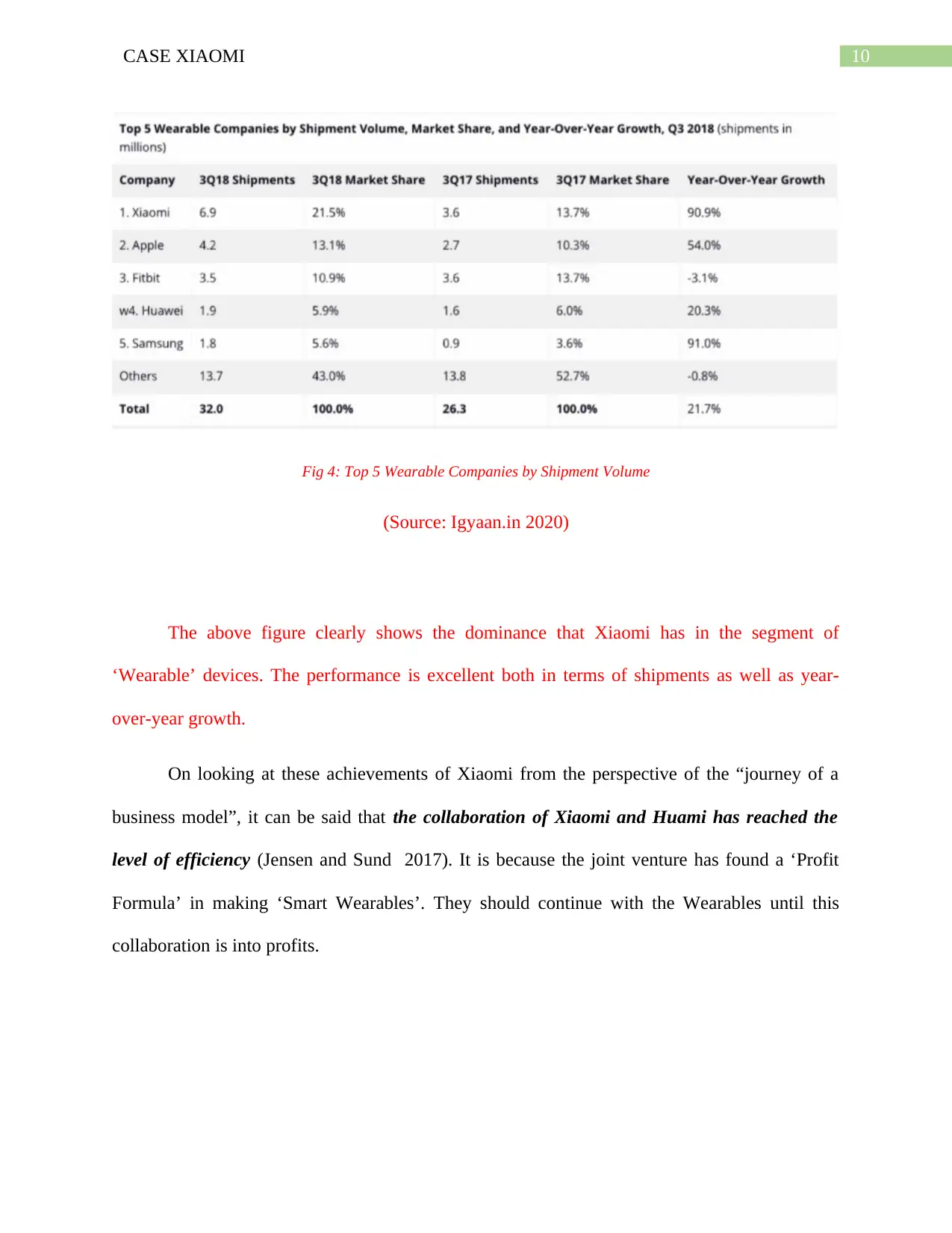
10CASE XIAOMI
Fig 4: Top 5 Wearable Companies by Shipment Volume
(Source: Igyaan.in 2020)
The above figure clearly shows the dominance that Xiaomi has in the segment of
‘Wearable’ devices. The performance is excellent both in terms of shipments as well as year-
over-year growth.
On looking at these achievements of Xiaomi from the perspective of the “journey of a
business model”, it can be said that the collaboration of Xiaomi and Huami has reached the
level of efficiency (Jensen and Sund 2017). It is because the joint venture has found a ‘Profit
Formula’ in making ‘Smart Wearables’. They should continue with the Wearables until this
collaboration is into profits.
Fig 4: Top 5 Wearable Companies by Shipment Volume
(Source: Igyaan.in 2020)
The above figure clearly shows the dominance that Xiaomi has in the segment of
‘Wearable’ devices. The performance is excellent both in terms of shipments as well as year-
over-year growth.
On looking at these achievements of Xiaomi from the perspective of the “journey of a
business model”, it can be said that the collaboration of Xiaomi and Huami has reached the
level of efficiency (Jensen and Sund 2017). It is because the joint venture has found a ‘Profit
Formula’ in making ‘Smart Wearables’. They should continue with the Wearables until this
collaboration is into profits.
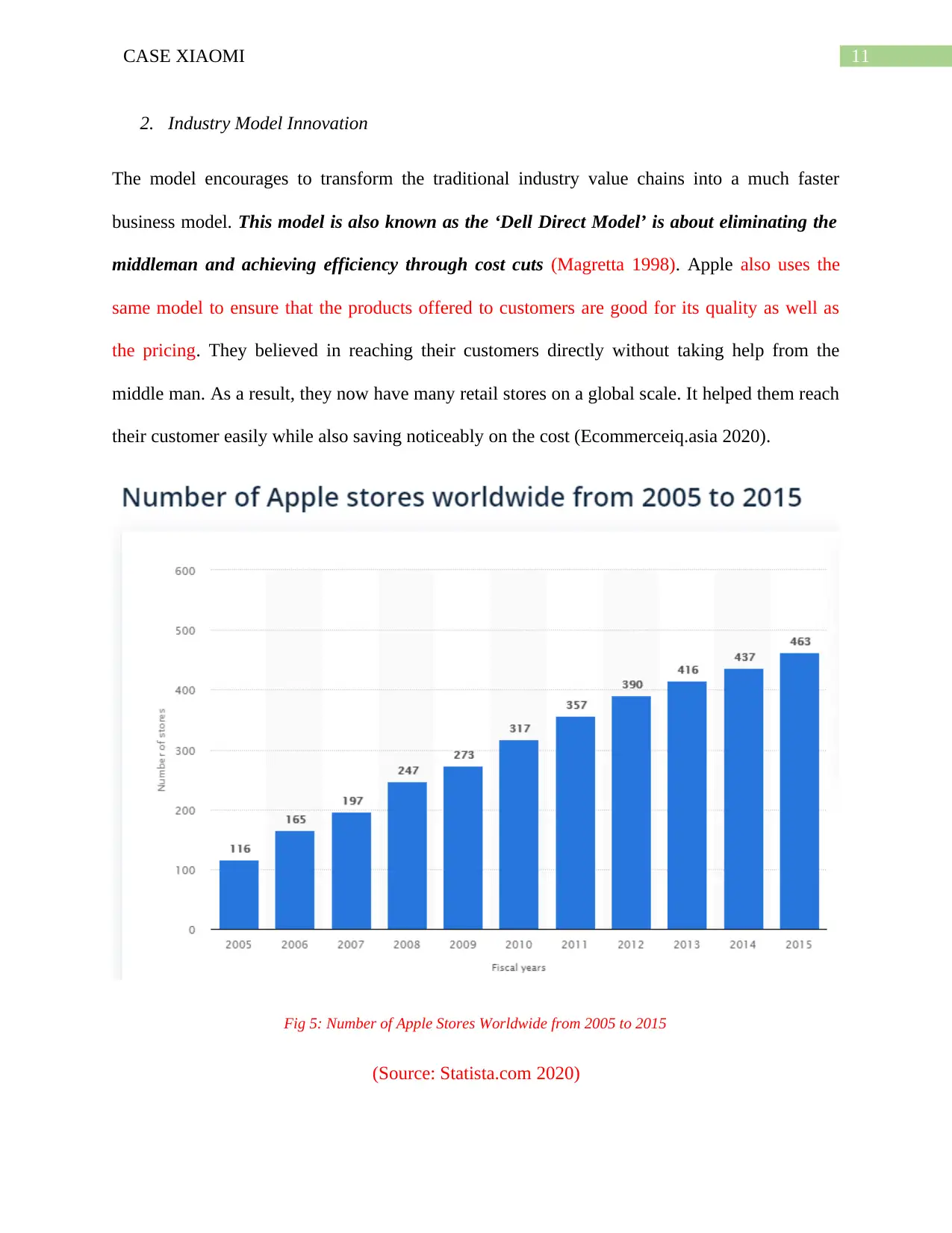
11CASE XIAOMI
2. Industry Model Innovation
The model encourages to transform the traditional industry value chains into a much faster
business model. This model is also known as the ‘Dell Direct Model’ is about eliminating the
middleman and achieving efficiency through cost cuts (Magretta 1998). Apple also uses the
same model to ensure that the products offered to customers are good for its quality as well as
the pricing. They believed in reaching their customers directly without taking help from the
middle man. As a result, they now have many retail stores on a global scale. It helped them reach
their customer easily while also saving noticeably on the cost (Ecommerceiq.asia 2020).
Fig 5: Number of Apple Stores Worldwide from 2005 to 2015
(Source: Statista.com 2020)
2. Industry Model Innovation
The model encourages to transform the traditional industry value chains into a much faster
business model. This model is also known as the ‘Dell Direct Model’ is about eliminating the
middleman and achieving efficiency through cost cuts (Magretta 1998). Apple also uses the
same model to ensure that the products offered to customers are good for its quality as well as
the pricing. They believed in reaching their customers directly without taking help from the
middle man. As a result, they now have many retail stores on a global scale. It helped them reach
their customer easily while also saving noticeably on the cost (Ecommerceiq.asia 2020).
Fig 5: Number of Apple Stores Worldwide from 2005 to 2015
(Source: Statista.com 2020)
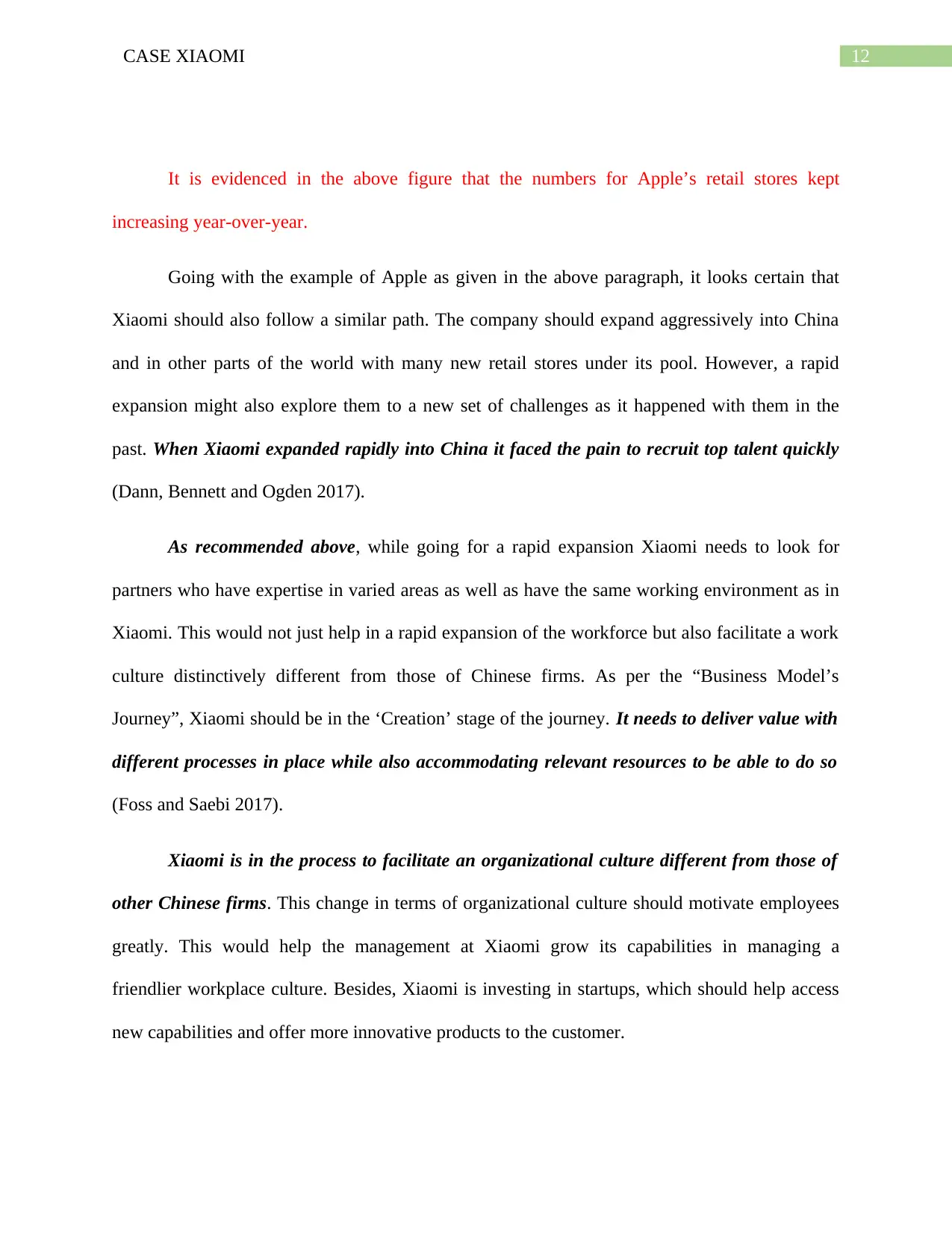
12CASE XIAOMI
It is evidenced in the above figure that the numbers for Apple’s retail stores kept
increasing year-over-year.
Going with the example of Apple as given in the above paragraph, it looks certain that
Xiaomi should also follow a similar path. The company should expand aggressively into China
and in other parts of the world with many new retail stores under its pool. However, a rapid
expansion might also explore them to a new set of challenges as it happened with them in the
past. When Xiaomi expanded rapidly into China it faced the pain to recruit top talent quickly
(Dann, Bennett and Ogden 2017).
As recommended above, while going for a rapid expansion Xiaomi needs to look for
partners who have expertise in varied areas as well as have the same working environment as in
Xiaomi. This would not just help in a rapid expansion of the workforce but also facilitate a work
culture distinctively different from those of Chinese firms. As per the “Business Model’s
Journey”, Xiaomi should be in the ‘Creation’ stage of the journey. It needs to deliver value with
different processes in place while also accommodating relevant resources to be able to do so
(Foss and Saebi 2017).
Xiaomi is in the process to facilitate an organizational culture different from those of
other Chinese firms. This change in terms of organizational culture should motivate employees
greatly. This would help the management at Xiaomi grow its capabilities in managing a
friendlier workplace culture. Besides, Xiaomi is investing in startups, which should help access
new capabilities and offer more innovative products to the customer.
It is evidenced in the above figure that the numbers for Apple’s retail stores kept
increasing year-over-year.
Going with the example of Apple as given in the above paragraph, it looks certain that
Xiaomi should also follow a similar path. The company should expand aggressively into China
and in other parts of the world with many new retail stores under its pool. However, a rapid
expansion might also explore them to a new set of challenges as it happened with them in the
past. When Xiaomi expanded rapidly into China it faced the pain to recruit top talent quickly
(Dann, Bennett and Ogden 2017).
As recommended above, while going for a rapid expansion Xiaomi needs to look for
partners who have expertise in varied areas as well as have the same working environment as in
Xiaomi. This would not just help in a rapid expansion of the workforce but also facilitate a work
culture distinctively different from those of Chinese firms. As per the “Business Model’s
Journey”, Xiaomi should be in the ‘Creation’ stage of the journey. It needs to deliver value with
different processes in place while also accommodating relevant resources to be able to do so
(Foss and Saebi 2017).
Xiaomi is in the process to facilitate an organizational culture different from those of
other Chinese firms. This change in terms of organizational culture should motivate employees
greatly. This would help the management at Xiaomi grow its capabilities in managing a
friendlier workplace culture. Besides, Xiaomi is investing in startups, which should help access
new capabilities and offer more innovative products to the customer.
Secure Best Marks with AI Grader
Need help grading? Try our AI Grader for instant feedback on your assignments.
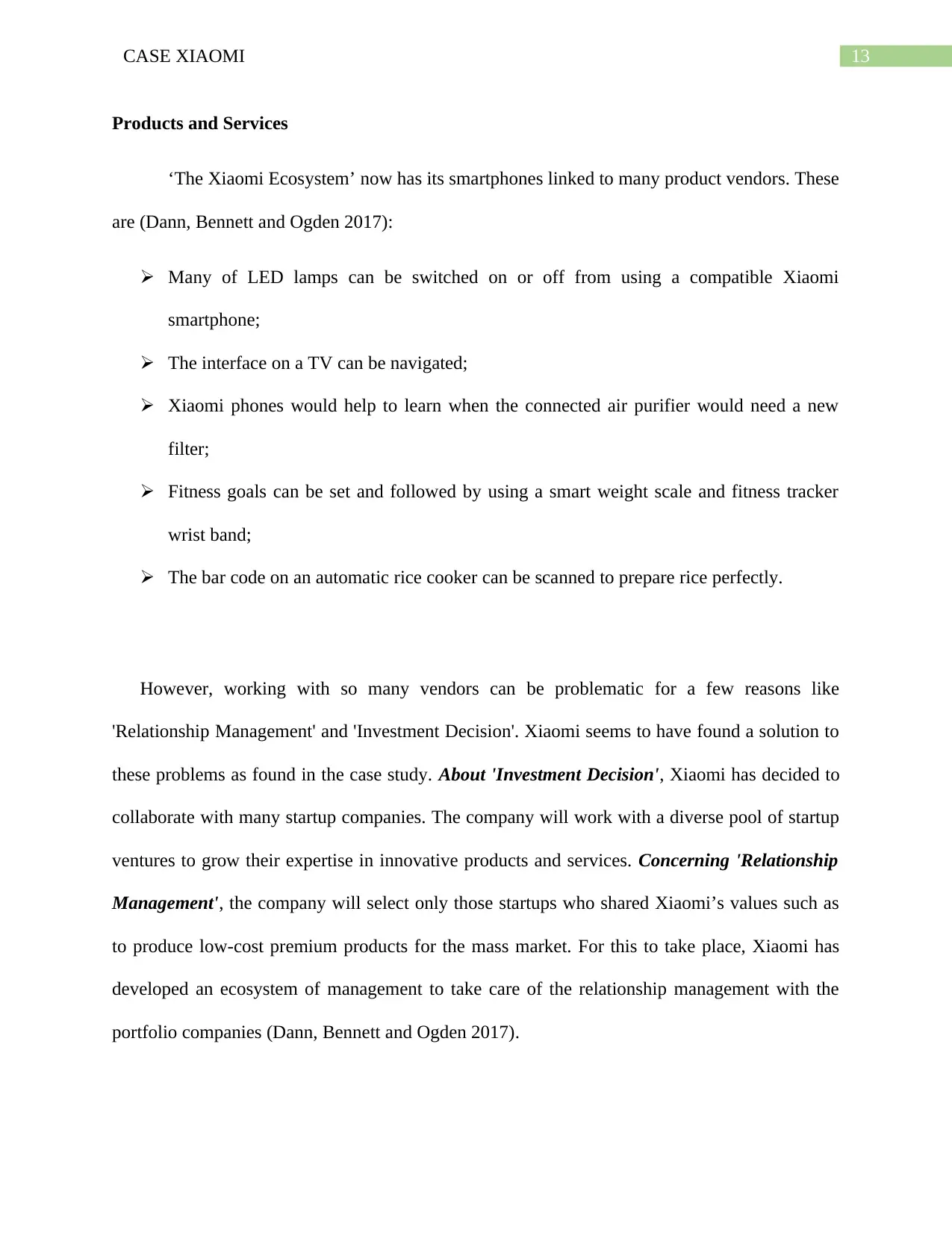
13CASE XIAOMI
Products and Services
‘The Xiaomi Ecosystem’ now has its smartphones linked to many product vendors. These
are (Dann, Bennett and Ogden 2017):
Many of LED lamps can be switched on or off from using a compatible Xiaomi
smartphone;
The interface on a TV can be navigated;
Xiaomi phones would help to learn when the connected air purifier would need a new
filter;
Fitness goals can be set and followed by using a smart weight scale and fitness tracker
wrist band;
The bar code on an automatic rice cooker can be scanned to prepare rice perfectly.
However, working with so many vendors can be problematic for a few reasons like
'Relationship Management' and 'Investment Decision'. Xiaomi seems to have found a solution to
these problems as found in the case study. About 'Investment Decision', Xiaomi has decided to
collaborate with many startup companies. The company will work with a diverse pool of startup
ventures to grow their expertise in innovative products and services. Concerning 'Relationship
Management', the company will select only those startups who shared Xiaomi’s values such as
to produce low-cost premium products for the mass market. For this to take place, Xiaomi has
developed an ecosystem of management to take care of the relationship management with the
portfolio companies (Dann, Bennett and Ogden 2017).
Products and Services
‘The Xiaomi Ecosystem’ now has its smartphones linked to many product vendors. These
are (Dann, Bennett and Ogden 2017):
Many of LED lamps can be switched on or off from using a compatible Xiaomi
smartphone;
The interface on a TV can be navigated;
Xiaomi phones would help to learn when the connected air purifier would need a new
filter;
Fitness goals can be set and followed by using a smart weight scale and fitness tracker
wrist band;
The bar code on an automatic rice cooker can be scanned to prepare rice perfectly.
However, working with so many vendors can be problematic for a few reasons like
'Relationship Management' and 'Investment Decision'. Xiaomi seems to have found a solution to
these problems as found in the case study. About 'Investment Decision', Xiaomi has decided to
collaborate with many startup companies. The company will work with a diverse pool of startup
ventures to grow their expertise in innovative products and services. Concerning 'Relationship
Management', the company will select only those startups who shared Xiaomi’s values such as
to produce low-cost premium products for the mass market. For this to take place, Xiaomi has
developed an ecosystem of management to take care of the relationship management with the
portfolio companies (Dann, Bennett and Ogden 2017).

14CASE XIAOMI
Processes
"The Xiaomi Ecosystem" needs robust support in the form of processes to be adopted.
The future of Xiaomi should have its retail stores expanded to a vast global area. The company
will also enjoy working with many product vendors to provide good support to its ecosystem. All
these will be on track if there are processes to support it. Organizational culture is one such area
that must change. Xiaomi is on a similar track as it facilitates a culture where people can enjoy
being a part of it. Good basic pay and other remuneration benefits will soon become a part of
Xiaomi. This should help attract more talent in quicker times (Iqbal, Guohao and Akhtar 2017).
Xiaomi needs more and more partners for being able to offer innovative products and services.
They have tied up with few companies like Huami. Xiaomi is also looking for startups those who
believe in the culture of Xiaomi (Dann, Bennett and Ogden 2017).
All the innovative initiatives such as those described in the study should help Xiaomi
deliver excellent performance in the long-term. All they need is an excellent market research and
flexibility with the changing trends. Sometimes in the future, they might be needed to make
quicker decisions. The ability to respond to the market will serve its purpose overtimes.
Challenges/Opportunities
Based on the findings of the sections such as (1. Future) and (2. Product, services,
Processes), below will be the challenges or opportunities for Xiaomi:
1. Xiaomi needs more retail presence (Opportunity)
2. Should continue with developing the ecosystem (Opportunity)
3. Effective relationship with the business partners (Opportunity)
Processes
"The Xiaomi Ecosystem" needs robust support in the form of processes to be adopted.
The future of Xiaomi should have its retail stores expanded to a vast global area. The company
will also enjoy working with many product vendors to provide good support to its ecosystem. All
these will be on track if there are processes to support it. Organizational culture is one such area
that must change. Xiaomi is on a similar track as it facilitates a culture where people can enjoy
being a part of it. Good basic pay and other remuneration benefits will soon become a part of
Xiaomi. This should help attract more talent in quicker times (Iqbal, Guohao and Akhtar 2017).
Xiaomi needs more and more partners for being able to offer innovative products and services.
They have tied up with few companies like Huami. Xiaomi is also looking for startups those who
believe in the culture of Xiaomi (Dann, Bennett and Ogden 2017).
All the innovative initiatives such as those described in the study should help Xiaomi
deliver excellent performance in the long-term. All they need is an excellent market research and
flexibility with the changing trends. Sometimes in the future, they might be needed to make
quicker decisions. The ability to respond to the market will serve its purpose overtimes.
Challenges/Opportunities
Based on the findings of the sections such as (1. Future) and (2. Product, services,
Processes), below will be the challenges or opportunities for Xiaomi:
1. Xiaomi needs more retail presence (Opportunity)
2. Should continue with developing the ecosystem (Opportunity)
3. Effective relationship with the business partners (Opportunity)

15CASE XIAOMI
4. Need to develop a friendlier organizational culture (Opportunity)
3. The Recommendation
Implementation for Opportunity 1
Concerning Xiaomi’s retail presence, it needs to present the prospect of the initiative to
its investors. The presentation should be done effectively by citing a list of opportunities and
challenges to be faced. Besides, the presentation should have justified solutions for the
challenges as needed to let investors believe in the initiative.
Implementation (Opportunity 2)
The facilitation of ‘The Xiaomi Ecosystem’ can be implemented using the below-listed
factors (Matzler et al. 2018):
Physical Product or Processes: Products such as TV, air purifier, etc.
Sensors: The use of sensors in the connected devices, so that, products get easily detected
from a compatible Xiaomi phone.
Connectivity: The use of IP-capable sensors would establish connectivity between the
phone and the connected device.
Analytics: This will collect data from the sensors analyzing which and implementing the
findings can help to deliver better service with the same device.
4. Need to develop a friendlier organizational culture (Opportunity)
3. The Recommendation
Implementation for Opportunity 1
Concerning Xiaomi’s retail presence, it needs to present the prospect of the initiative to
its investors. The presentation should be done effectively by citing a list of opportunities and
challenges to be faced. Besides, the presentation should have justified solutions for the
challenges as needed to let investors believe in the initiative.
Implementation (Opportunity 2)
The facilitation of ‘The Xiaomi Ecosystem’ can be implemented using the below-listed
factors (Matzler et al. 2018):
Physical Product or Processes: Products such as TV, air purifier, etc.
Sensors: The use of sensors in the connected devices, so that, products get easily detected
from a compatible Xiaomi phone.
Connectivity: The use of IP-capable sensors would establish connectivity between the
phone and the connected device.
Analytics: This will collect data from the sensors analyzing which and implementing the
findings can help to deliver better service with the same device.
Paraphrase This Document
Need a fresh take? Get an instant paraphrase of this document with our AI Paraphraser
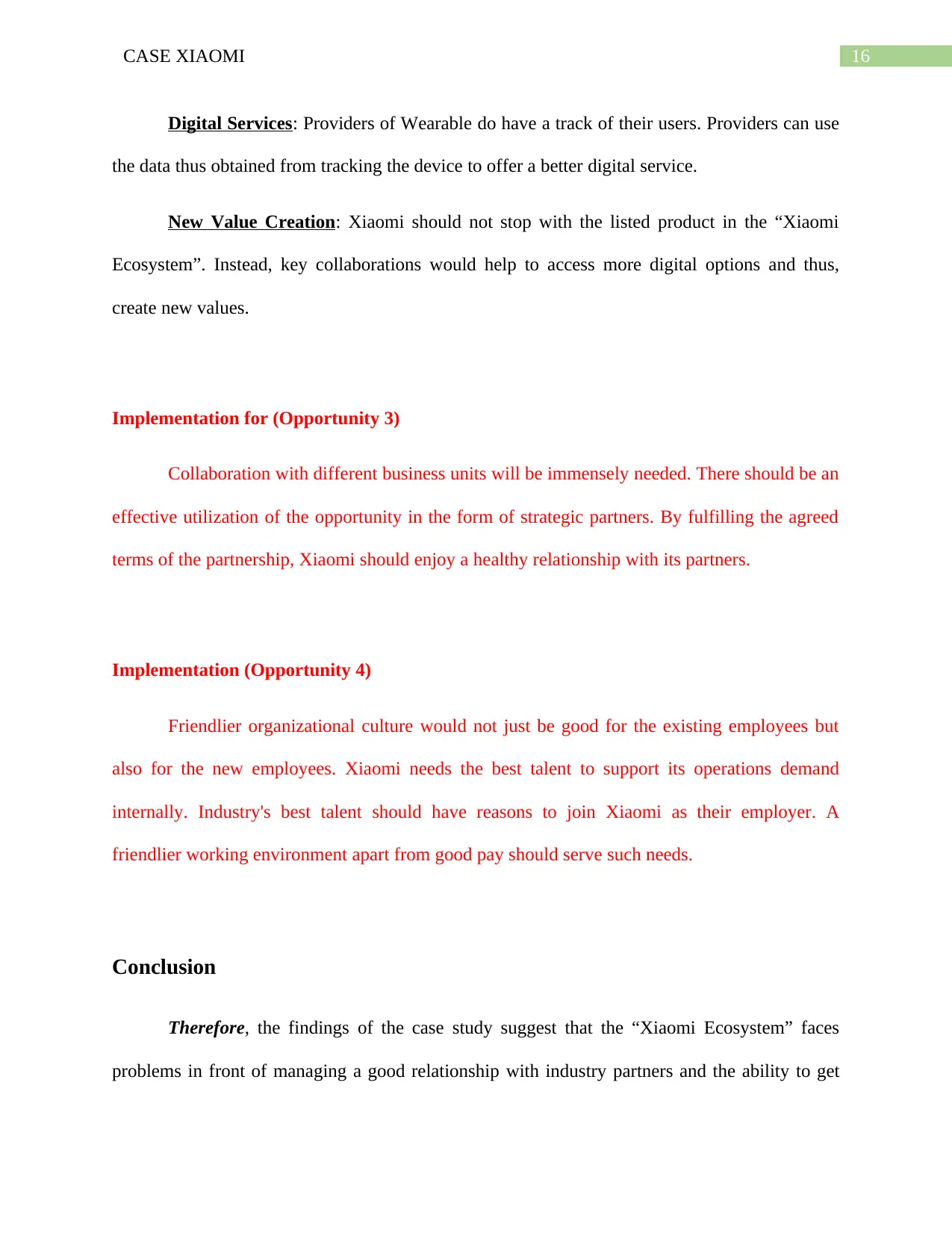
16CASE XIAOMI
Digital Services: Providers of Wearable do have a track of their users. Providers can use
the data thus obtained from tracking the device to offer a better digital service.
New Value Creation: Xiaomi should not stop with the listed product in the “Xiaomi
Ecosystem”. Instead, key collaborations would help to access more digital options and thus,
create new values.
Implementation for (Opportunity 3)
Collaboration with different business units will be immensely needed. There should be an
effective utilization of the opportunity in the form of strategic partners. By fulfilling the agreed
terms of the partnership, Xiaomi should enjoy a healthy relationship with its partners.
Implementation (Opportunity 4)
Friendlier organizational culture would not just be good for the existing employees but
also for the new employees. Xiaomi needs the best talent to support its operations demand
internally. Industry's best talent should have reasons to join Xiaomi as their employer. A
friendlier working environment apart from good pay should serve such needs.
Conclusion
Therefore, the findings of the case study suggest that the “Xiaomi Ecosystem” faces
problems in front of managing a good relationship with industry partners and the ability to get
Digital Services: Providers of Wearable do have a track of their users. Providers can use
the data thus obtained from tracking the device to offer a better digital service.
New Value Creation: Xiaomi should not stop with the listed product in the “Xiaomi
Ecosystem”. Instead, key collaborations would help to access more digital options and thus,
create new values.
Implementation for (Opportunity 3)
Collaboration with different business units will be immensely needed. There should be an
effective utilization of the opportunity in the form of strategic partners. By fulfilling the agreed
terms of the partnership, Xiaomi should enjoy a healthy relationship with its partners.
Implementation (Opportunity 4)
Friendlier organizational culture would not just be good for the existing employees but
also for the new employees. Xiaomi needs the best talent to support its operations demand
internally. Industry's best talent should have reasons to join Xiaomi as their employer. A
friendlier working environment apart from good pay should serve such needs.
Conclusion
Therefore, the findings of the case study suggest that the “Xiaomi Ecosystem” faces
problems in front of managing a good relationship with industry partners and the ability to get
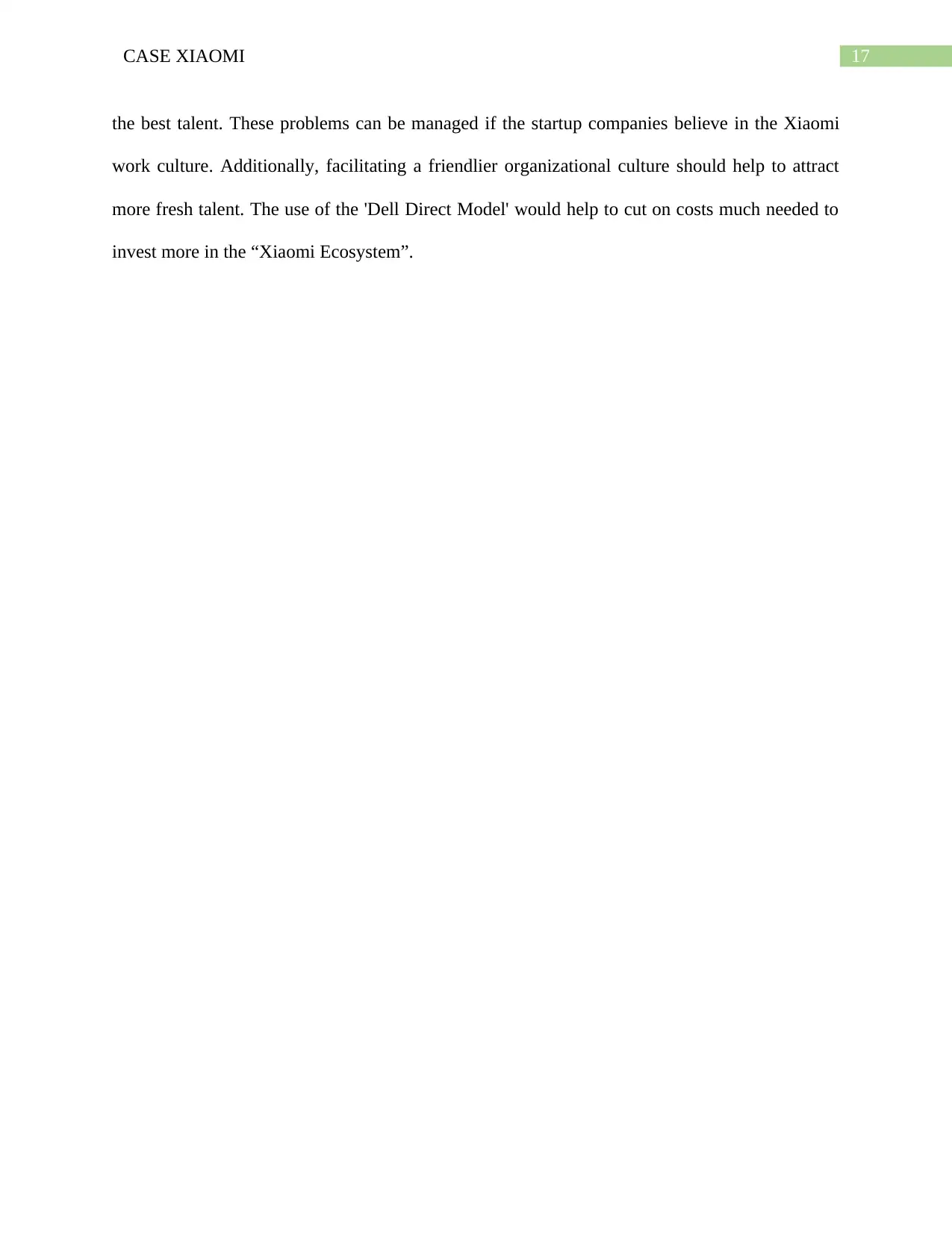
17CASE XIAOMI
the best talent. These problems can be managed if the startup companies believe in the Xiaomi
work culture. Additionally, facilitating a friendlier organizational culture should help to attract
more fresh talent. The use of the 'Dell Direct Model' would help to cut on costs much needed to
invest more in the “Xiaomi Ecosystem”.
the best talent. These problems can be managed if the startup companies believe in the Xiaomi
work culture. Additionally, facilitating a friendlier organizational culture should help to attract
more fresh talent. The use of the 'Dell Direct Model' would help to cut on costs much needed to
invest more in the “Xiaomi Ecosystem”.
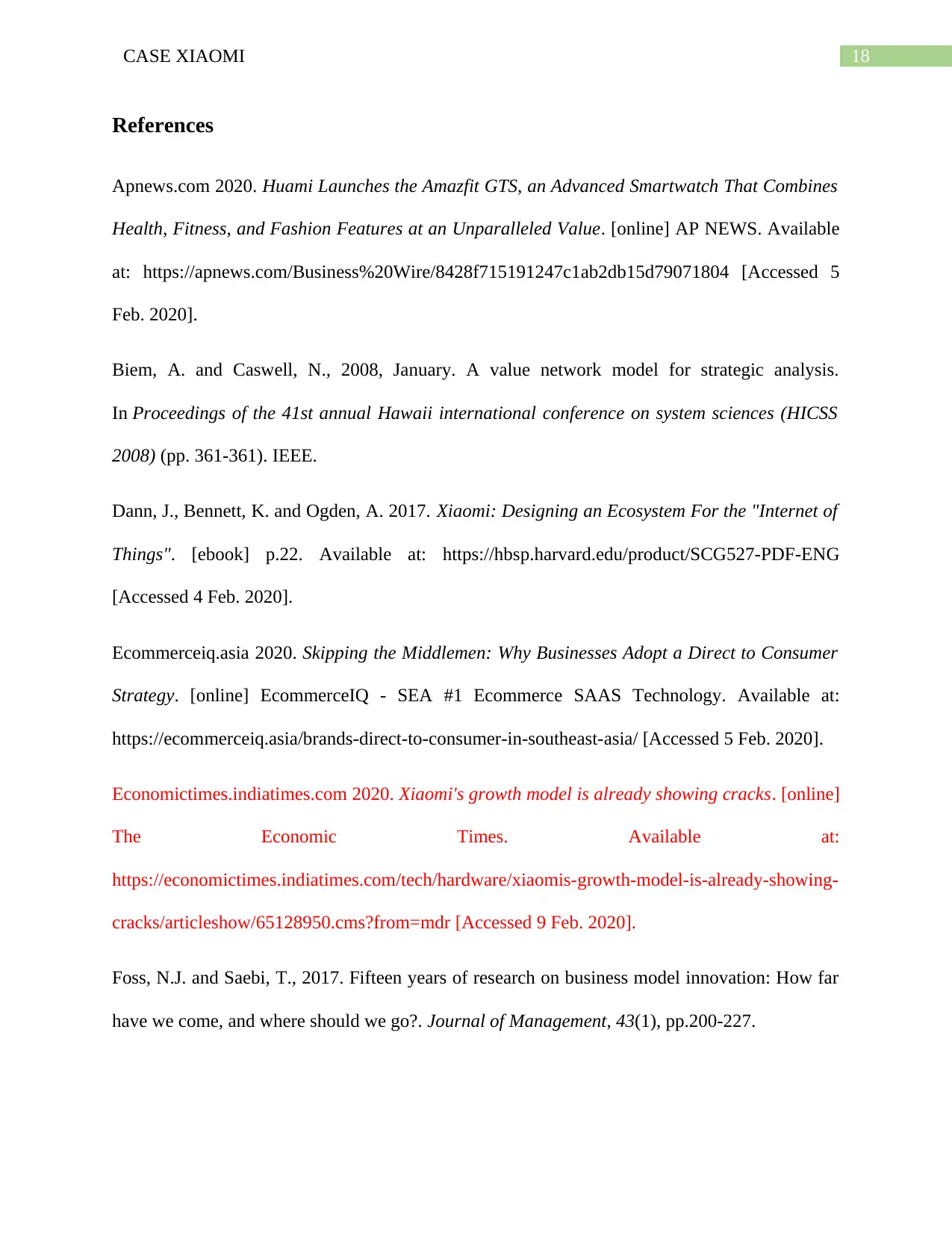
18CASE XIAOMI
References
Apnews.com 2020. Huami Launches the Amazfit GTS, an Advanced Smartwatch That Combines
Health, Fitness, and Fashion Features at an Unparalleled Value. [online] AP NEWS. Available
at: https://apnews.com/Business%20Wire/8428f715191247c1ab2db15d79071804 [Accessed 5
Feb. 2020].
Biem, A. and Caswell, N., 2008, January. A value network model for strategic analysis.
In Proceedings of the 41st annual Hawaii international conference on system sciences (HICSS
2008) (pp. 361-361). IEEE.
Dann, J., Bennett, K. and Ogden, A. 2017. Xiaomi: Designing an Ecosystem For the "Internet of
Things". [ebook] p.22. Available at: https://hbsp.harvard.edu/product/SCG527-PDF-ENG
[Accessed 4 Feb. 2020].
Ecommerceiq.asia 2020. Skipping the Middlemen: Why Businesses Adopt a Direct to Consumer
Strategy. [online] EcommerceIQ - SEA #1 Ecommerce SAAS Technology. Available at:
https://ecommerceiq.asia/brands-direct-to-consumer-in-southeast-asia/ [Accessed 5 Feb. 2020].
Economictimes.indiatimes.com 2020. Xiaomi's growth model is already showing cracks. [online]
The Economic Times. Available at:
https://economictimes.indiatimes.com/tech/hardware/xiaomis-growth-model-is-already-showing-
cracks/articleshow/65128950.cms?from=mdr [Accessed 9 Feb. 2020].
Foss, N.J. and Saebi, T., 2017. Fifteen years of research on business model innovation: How far
have we come, and where should we go?. Journal of Management, 43(1), pp.200-227.
References
Apnews.com 2020. Huami Launches the Amazfit GTS, an Advanced Smartwatch That Combines
Health, Fitness, and Fashion Features at an Unparalleled Value. [online] AP NEWS. Available
at: https://apnews.com/Business%20Wire/8428f715191247c1ab2db15d79071804 [Accessed 5
Feb. 2020].
Biem, A. and Caswell, N., 2008, January. A value network model for strategic analysis.
In Proceedings of the 41st annual Hawaii international conference on system sciences (HICSS
2008) (pp. 361-361). IEEE.
Dann, J., Bennett, K. and Ogden, A. 2017. Xiaomi: Designing an Ecosystem For the "Internet of
Things". [ebook] p.22. Available at: https://hbsp.harvard.edu/product/SCG527-PDF-ENG
[Accessed 4 Feb. 2020].
Ecommerceiq.asia 2020. Skipping the Middlemen: Why Businesses Adopt a Direct to Consumer
Strategy. [online] EcommerceIQ - SEA #1 Ecommerce SAAS Technology. Available at:
https://ecommerceiq.asia/brands-direct-to-consumer-in-southeast-asia/ [Accessed 5 Feb. 2020].
Economictimes.indiatimes.com 2020. Xiaomi's growth model is already showing cracks. [online]
The Economic Times. Available at:
https://economictimes.indiatimes.com/tech/hardware/xiaomis-growth-model-is-already-showing-
cracks/articleshow/65128950.cms?from=mdr [Accessed 9 Feb. 2020].
Foss, N.J. and Saebi, T., 2017. Fifteen years of research on business model innovation: How far
have we come, and where should we go?. Journal of Management, 43(1), pp.200-227.
Secure Best Marks with AI Grader
Need help grading? Try our AI Grader for instant feedback on your assignments.
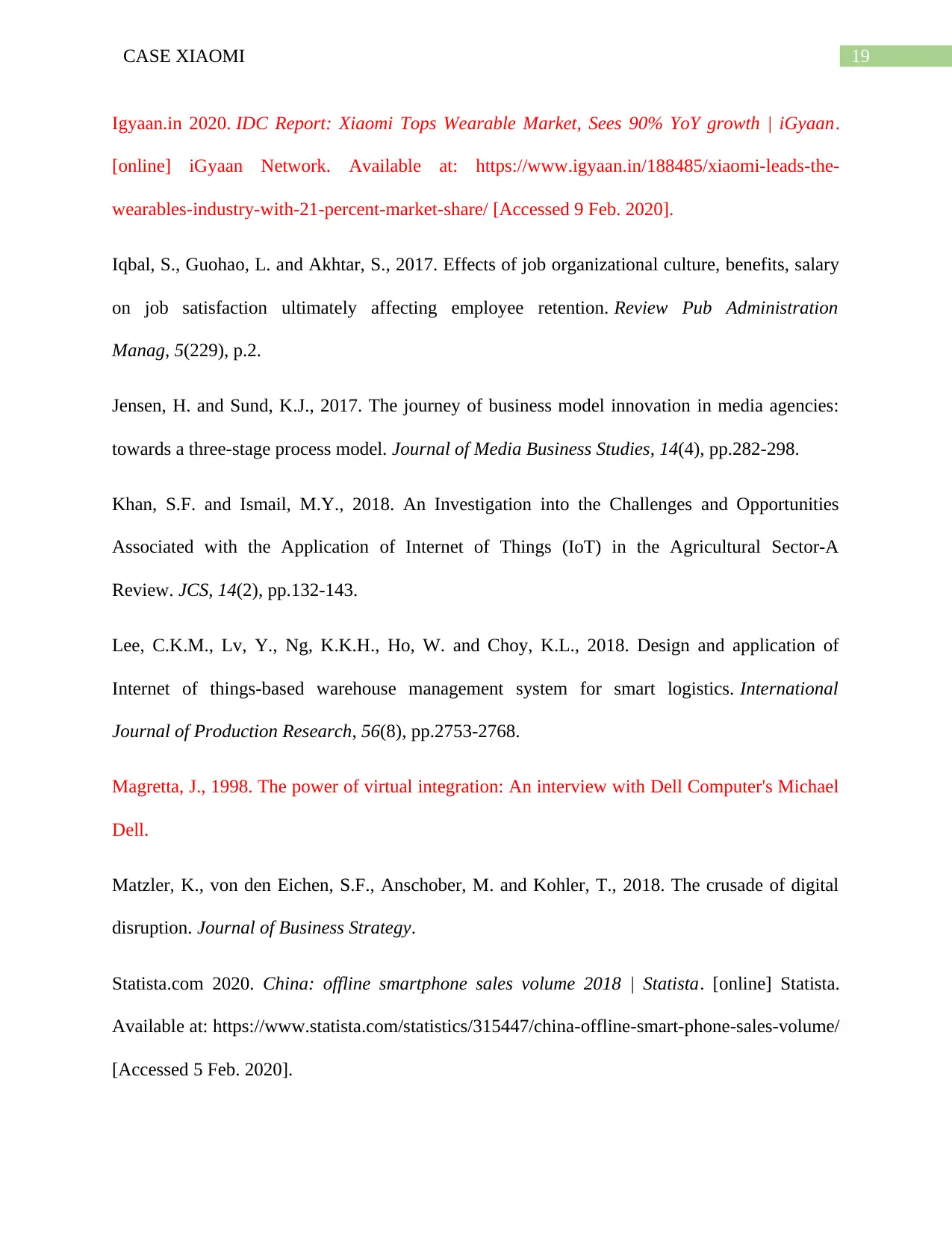
19CASE XIAOMI
Igyaan.in 2020. IDC Report: Xiaomi Tops Wearable Market, Sees 90% YoY growth | iGyaan.
[online] iGyaan Network. Available at: https://www.igyaan.in/188485/xiaomi-leads-the-
wearables-industry-with-21-percent-market-share/ [Accessed 9 Feb. 2020].
Iqbal, S., Guohao, L. and Akhtar, S., 2017. Effects of job organizational culture, benefits, salary
on job satisfaction ultimately affecting employee retention. Review Pub Administration
Manag, 5(229), p.2.
Jensen, H. and Sund, K.J., 2017. The journey of business model innovation in media agencies:
towards a three-stage process model. Journal of Media Business Studies, 14(4), pp.282-298.
Khan, S.F. and Ismail, M.Y., 2018. An Investigation into the Challenges and Opportunities
Associated with the Application of Internet of Things (IoT) in the Agricultural Sector-A
Review. JCS, 14(2), pp.132-143.
Lee, C.K.M., Lv, Y., Ng, K.K.H., Ho, W. and Choy, K.L., 2018. Design and application of
Internet of things-based warehouse management system for smart logistics. International
Journal of Production Research, 56(8), pp.2753-2768.
Magretta, J., 1998. The power of virtual integration: An interview with Dell Computer's Michael
Dell.
Matzler, K., von den Eichen, S.F., Anschober, M. and Kohler, T., 2018. The crusade of digital
disruption. Journal of Business Strategy.
Statista.com 2020. China: offline smartphone sales volume 2018 | Statista. [online] Statista.
Available at: https://www.statista.com/statistics/315447/china-offline-smart-phone-sales-volume/
[Accessed 5 Feb. 2020].
Igyaan.in 2020. IDC Report: Xiaomi Tops Wearable Market, Sees 90% YoY growth | iGyaan.
[online] iGyaan Network. Available at: https://www.igyaan.in/188485/xiaomi-leads-the-
wearables-industry-with-21-percent-market-share/ [Accessed 9 Feb. 2020].
Iqbal, S., Guohao, L. and Akhtar, S., 2017. Effects of job organizational culture, benefits, salary
on job satisfaction ultimately affecting employee retention. Review Pub Administration
Manag, 5(229), p.2.
Jensen, H. and Sund, K.J., 2017. The journey of business model innovation in media agencies:
towards a three-stage process model. Journal of Media Business Studies, 14(4), pp.282-298.
Khan, S.F. and Ismail, M.Y., 2018. An Investigation into the Challenges and Opportunities
Associated with the Application of Internet of Things (IoT) in the Agricultural Sector-A
Review. JCS, 14(2), pp.132-143.
Lee, C.K.M., Lv, Y., Ng, K.K.H., Ho, W. and Choy, K.L., 2018. Design and application of
Internet of things-based warehouse management system for smart logistics. International
Journal of Production Research, 56(8), pp.2753-2768.
Magretta, J., 1998. The power of virtual integration: An interview with Dell Computer's Michael
Dell.
Matzler, K., von den Eichen, S.F., Anschober, M. and Kohler, T., 2018. The crusade of digital
disruption. Journal of Business Strategy.
Statista.com 2020. China: offline smartphone sales volume 2018 | Statista. [online] Statista.
Available at: https://www.statista.com/statistics/315447/china-offline-smart-phone-sales-volume/
[Accessed 5 Feb. 2020].

20CASE XIAOMI
Statista.com 2020. China: offline smartphone sales volume 2018 | Statista. [online] Statista.
Available at: https://www.statista.com/statistics/315447/china-offline-smart-phone-sales-volume/
[Accessed 9 Feb. 2020].
Statista.com 2020. Number of Apple stores worldwide 2015 | Statista. [online] Statista. Available
at: https://www.statista.com/statistics/273480/number-of-apple-stores-worldwide-since-2005/
[Accessed 9 Feb. 2020].
Teece, D.J., 2018. Business models and dynamic capabilities. Long Range Planning, 51(1),
pp.40-49.
Statista.com 2020. China: offline smartphone sales volume 2018 | Statista. [online] Statista.
Available at: https://www.statista.com/statistics/315447/china-offline-smart-phone-sales-volume/
[Accessed 9 Feb. 2020].
Statista.com 2020. Number of Apple stores worldwide 2015 | Statista. [online] Statista. Available
at: https://www.statista.com/statistics/273480/number-of-apple-stores-worldwide-since-2005/
[Accessed 9 Feb. 2020].
Teece, D.J., 2018. Business models and dynamic capabilities. Long Range Planning, 51(1),
pp.40-49.
1 out of 21
Related Documents
Your All-in-One AI-Powered Toolkit for Academic Success.
+13062052269
info@desklib.com
Available 24*7 on WhatsApp / Email
![[object Object]](/_next/static/media/star-bottom.7253800d.svg)
Unlock your academic potential
© 2024 | Zucol Services PVT LTD | All rights reserved.





